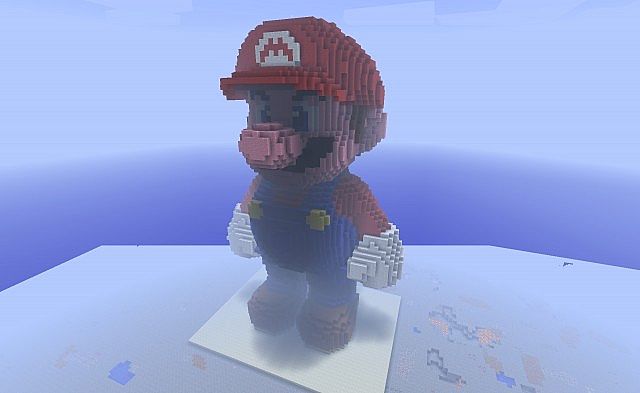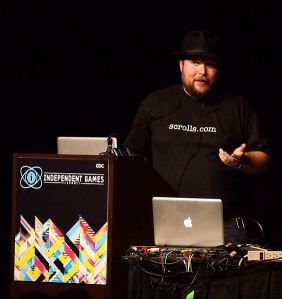 2009年,32岁的程序员马库斯•佩尔松开始着手开发一个名为Minecraft的编外项目,当时,几乎没有任何迹象显示它会成功。他的老板当然也没有想到。“说老实话,我当时看不出它有任何潜力,”时任照片共享网站jAlbum CEO的卡尔•梅奈说。没过多久,Minecraft创造的收入就超越了jAlbum。梅奈意识到自己完全错了。现在,梅奈率领独立视频游戏开发商Mojang公司的25位员工,全身心地致力于这款游戏的开发工作。Minecraft业已成为游戏业的新贵,而且发展势头没有显示出一丝放缓的迹象。
2009年,32岁的程序员马库斯•佩尔松开始着手开发一个名为Minecraft的编外项目,当时,几乎没有任何迹象显示它会成功。他的老板当然也没有想到。“说老实话,我当时看不出它有任何潜力,”时任照片共享网站jAlbum CEO的卡尔•梅奈说。没过多久,Minecraft创造的收入就超越了jAlbum。梅奈意识到自己完全错了。现在,梅奈率领独立视频游戏开发商Mojang公司的25位员工,全身心地致力于这款游戏的开发工作。Minecraft业已成为游戏业的新贵,而且发展势头没有显示出一丝放缓的迹象。
唯有在最松散的意义上,Minecraft才称得上是一款视频游戏,更准确地说,它是一款数字沙盘游戏。玩家们使用类似于各种多边形积木的3D立方体,自由构建建筑物和物体。这款可在个人电脑、苹果(Apple)和谷歌(Google)手机等平台上运行的游戏没有运用时常在当代电脑游戏上看到的那种电影大片式的超现实图像。Minecraft的像素和块状材质让它看起来像是雅达利(Atari,美国一家电脑游戏机厂商——译注)时代的遗物。在一种模式中,玩家们必须在白天收集资源,在晚上击退怪物的攻击;在另一种模式中,玩家们可自由创建他们喜欢的任何东西。
这款游戏的难度增添了它的守旧风格。学起来或许颇费脑力。游戏开发者没有提供使用手册,而是鼓励用户与一位“导师”交朋友,向他学习使用方法,或者在用户论坛和网络视频上搜寻游戏诀窍,比如怎样寻找原材料,怎样建造巨大的纪念碑等等。“人们喜欢Minecraft,与喜欢创造自己的音乐录影带或尝试着在Etsy网销售自己的手工艺品的原因如出一辙,”游戏产业网站 GamaSutra自由编辑李•亚历山大解释道。
这款自由形态的游戏催生出了一种活力四射的文化:玩家创造并在线分享自己的设计。过去一年中,一个常见的网络惹点“玩家某某某又在Minecraft上重新创建了某某事东西”,比如著名建筑师弗兰克•劳埃德•赖设计的流水别墅(Fallingwater),电影《哈利•波特》中的霍格沃茨魔法学校(Hogwarts)等等。虽然 Mojang公司的开发团队表示,其最大的
用户群体是15岁以下的孩童,但Minecraft用户的年龄分布在9到70岁之间,既有休闲玩家,也有骨灰级高手。到目前为止,这款游戏的注册用户已经超过了2,500万人,其中500万用户付款预定了一个增添了许多新功能的高级版本。
这一切已经转化为一门不可小觑的生意。至2011年年底,Mojang公司创造了8,000万美元的收入,1,350万美元的利润。大型游戏发行商纷纷登门洽谈收购事宜,据说报价已经接近10亿美元。明星企业家肖恩•帕克邀请开发人员飞赴伦敦参加一个聚会,希望讨得他们的欢心,让自己成为一位未来的投资者。
Minecraft游戏年度盛会MineCon是一个绝佳的晴雨表,从中可看出这款游戏流行指数的飙升。2年前在华盛顿贝尔维尤举行的第一次集会非常低调,只有佩尔松和大约50位忠实拥趸参加。去年11月份,MineCon吸引了约5,000名粉丝,挤满了拉斯维加斯的曼德勒海湾博彩酒店。梅奈说:“当我们从(位于瑞典的)狭小办公室来到MineCon,见到这些人时,我们意识到Minecraft用户群已经多么庞大,这款游戏已经产生了怎样的影响力。”
Minecraft的成功在很大程度上应归功于其开发者佩尔松,业内人士认为他是一位机智过人的游戏天才。在加入jAlbum公司之前,佩尔松曾经在国王网(King.com)做了大约4年半的程序员,开发了一些益智休闲类和射击类游戏,比如《搞怪农场》(Funny Farm)和《嘉年华枪战》(Carnival Shootout)。佩尔松从未梦想过自己有朝一日会成为一位百万富翁,更不用说业界明星!依然在网上自称“诺奇(Notch)”的佩尔松已经拥有了巨大的影响力。超过64万人在Twitter上关注他频繁更新的留言,他在Google+上的粉丝亦有11.23万人(佩尔松拒绝接受本文作者的采访)。
 实际上,Minecraft用户喜欢的不仅仅是这款游戏本身,他们同样钟爱佩尔松反正统的人格魅力。他首先是一位出色的程序员,但他从不回避争议话题。去年在接受一家行业性期刊采访时,佩尔松说他或许在吃午饭时就彻底打消了艺电公司(Electronic Arts)老板约翰•里奇蒂耶洛潜在的收购希望。当游戏开发商OMGPOP公司(最近被社交游戏开发商Zynga公司以2.1亿美元的价格收购)CEO因一位员工不愿加入Zynga公司而发表蔑视性言论时,佩尔松站出来替这位员工辩护了一番。他在Twitter上反击称:“你就是一个精神失常的白痴。”当一位粉丝在Twitter上哀叹自己买不起Minecraft,佩尔松公开建议他使用盗版软件。去年,佩尔松没有把近300万美元的分红装入自己口袋,而是将其回赠给Mojang公司的员工,再次提升了他的罗宾汉形象。
实际上,Minecraft用户喜欢的不仅仅是这款游戏本身,他们同样钟爱佩尔松反正统的人格魅力。他首先是一位出色的程序员,但他从不回避争议话题。去年在接受一家行业性期刊采访时,佩尔松说他或许在吃午饭时就彻底打消了艺电公司(Electronic Arts)老板约翰•里奇蒂耶洛潜在的收购希望。当游戏开发商OMGPOP公司(最近被社交游戏开发商Zynga公司以2.1亿美元的价格收购)CEO因一位员工不愿加入Zynga公司而发表蔑视性言论时,佩尔松站出来替这位员工辩护了一番。他在Twitter上反击称:“你就是一个精神失常的白痴。”当一位粉丝在Twitter上哀叹自己买不起Minecraft,佩尔松公开建议他使用盗版软件。去年,佩尔松没有把近300万美元的分红装入自己口袋,而是将其回赠给Mojang公司的员工,再次提升了他的罗宾汉形象。
更重要的是,Mojang公司没有遵循游戏业的两大趋势。它既不同于益智休闲游戏开发商Zynga和Rovio——不断推出人们在乘地铁或上班时用来消遣的低成本甚或零成本游戏,也不同于大型游戏开发商EA和Activision——它们的运作手法颇类似于好莱坞电影公司,往往斥资数百万甚至数亿美元开发诸如《使命召唤》(Call of Duty)这样的复杂游戏。
Mojang公司独特的开发风格或许最接近于暴雪娱乐公司(Blizzard),这家位于加州尔湾市的小公司开发出了史上最赚钱的游戏之一《魔兽世界》(World of Warcraft)。暴雪娱乐公司最终于2007年与Activision公司合并,这桩价值189亿美元的联姻创造出了世界上最大的游戏开发商。
Mojang公司正在寻求扩张之道,除了接受收购,该公司愿意尝试一切方式。其中包括下注于一款名为Scrolls、与Minecraft风马牛不相及的全新探险游戏。Mojang公司将在接下来的2个月中,邀请少数玩家对这款游戏进行“封闭内测”。本周早些时候,佩尔森宣布推出另一款多人太空旅行游戏,它有一个听起来雄心勃勃的名字:0×10C。
视频游戏公司TechSavvy业务咨询总监斯科特•斯坦伯格说,保持Minecraft自身全面增长的关键是探索对这款游戏来说有意义的机会。有人建议Mojang公司把这款游戏开发成一档电视节目或一部电影,但该公司还没有对此作出任何承诺。今年5月,这款游戏的一个版本将进入微软公司(Microsoft)的游戏网络平台Xbox Live。这款游戏的特许经营去年产生了
将近100万美元的收入,今年晚些时候,受Minecraft启发的新款乐高(Lego)玩具正式推出之后,特许经营收入海景大幅攀升。但是,这一切对于佩尔森和他的团队而言很可能仅仅只是个开始。
When programmer Markus Persson, 32, began working on a side project called Minecraft in 2009 there was little to indicate it would go anywhere. His boss certainly didn't think so. "I didn't see any potential in it, and that's the honest truth," says Carl Manneh, who was then CEO of photo-sharing site jAlbum.
When Minecraft revenues surpassed jAlbum's shortly thereafter, Manneh realized just how wrong he'd been. Now, Manneh runs Mojang, the 25-person team behind the game. And Minecraft has become a gaming phenom with no signs of slowing down.
Minecraft is a videogame only in the loosest sense. Digital sandbox is a more accurate description. Players are free to construct buildings and objects out of 3D cubes, polygonal Legos of sorts. The program, which is available for PCs as well as Apple and Google phones, eschews the ultra-realistic, blockbuster graphics of contemporary computer games. With its pixelated, blocky textures, Minecraft looks like a relic from the Atari era. In one mode, players must gather resources during the day and fend off monster attacks at night; in another, they are free to create whatever they like.
The game's difficulty adds to the old school flavor. The learning curve can be punishing. In lieu of a manual, users are encouraged to buddy up with a "mentor" to show them the ropes or crawl user forums and web videos for tips on everything from scavenging for materials to building huge monuments. "The same thing that draws people to Minecraft is the same thing that draws people to make their own music videos or to try to sell their own crafts on Etsy," explains Leigh Alexander, editor-at-large for game industry web site GamaSutra.
This freeform gameplay has generated a robust culture, with players creating and sharing their designs online. A common internet meme over the past year has been "xyz re-created in Minecraft," from Frank Lloyd Wright's Fallingwater to Harry Potter's Hogwarts. Although the Mojang team says its largest demographic set is under 15, Minecraft's users range in age from 9 to 70, casual gamer to seasoned veteran. To date, the game has more than 25 million registered users, 5 million of which paid upfront for a premium version with additional features.
That has translated into a real business. The company reported $80 million in revenues -- and $13.5 million in profit -- through the end of 2011. Large publishers have come knocking with acquisition bids, rumored to be worth close to $1 billion. And rockstar entrepreneur Sean Parker flew the developers to Londonfor a party hoping to woo them as a future investor.
A good barometer of how rapidly the game has grown in popularity is MineCon, the annual Minecraft convention. Its first gathering in Bellevue, Washingtontwo years ago was a low key affair attended by Persson and around 50 other devotees. Last November, MineCon drew 5,000 fans, packing the Mandalay Bay Hotel and Casino in Las Vegas. "Going from your small offices [in Sweden] to MineCon, and meeting these people, that's when we realized how big Minecraft was and what kind of impact the game has made," says Manneh.
Key to maintaining overall growth of Minecraft itself will be exploring opportunities that make sense for the game, says Scott Steinberg, head of business consulting for the video games firm TechSavvy. Mojang has been approached to develop the game into a TV show or film, although the company hasn't committed to anything yet. A version of the game is headed to Microsoft's (MSFT) Xbox Live this May. And merchandise, which generated nearly $1 million last year, will get a big boost later this year when an official Minecraft-inspired Lego set arrives. For Persson and crew, that is likely only to be the beginning.
Mojang is looking at ways to expand, which includes everything short of being acquired. That includes placing its bets on an all-new unrelated adventure game called Scrolls, which will initially roll out in an invite-only "closed alpha" in the next two months. And earlier this week, Persson announced another game, dubbed 0×10C, an ambitious-sounding multiplayer space travel game.
More importantly, Minecraft's parent Mojang is bucking two of the biggest trends in games. It is unlike casual game makers Zynga and Rovio, pumping out low- and no-cost titles people play as diversions on the subway or at work. Nor is it like larger game firms EA and Activision (ATVI), which operate much like Hollywood studios, investing tens and sometimes hundreds of millions developing complex titles like Call of Duty. With its idiosyncratic approach, it is most like the old Blizzard, the small Irvine, California studio that wound up creating World of Warcraft, one of the most profitable franchises in history. (It eventually merged with Activision in 2007, an $18.9 billion tie up that created the world's largest game maker.)
Indeed, just as appealing to fans as Minecraft itself is Persson's anti-establishment persona. He is above all a programmer, but he hasn't shied away from controversy. In an interview with an industry trade publication last year, Persson said he may have quashed Electronic Arts (EA) boss John Riccitello's potential acquisition hopes over lunch. When the CEO of game maker OMGPOP, which was recently acquired for $210 million by Zynga (ZNGA), made disparaging remarks about the one employee who did not make the move, Persson came to his defense. He shot back on Twitter, "You're an insane idiot." And when a fan admitted, also via Twitter, that he couldn't to afford to buy Minecraft, Persson publicly recommended he pirate a copy. Instead of pocketing nearly $3 million in dividends last year, he gave it back to Mojang employees, bolstering his Robin Hood image.
Minecraft's success is largely due to Persson, its creator, described by industry insiders as bright with a sharp wit. He worked for some four-and-a-half years as a programmer for King.com, developing casual puzzle and shooting games with names like Funny Farm and Carnival Shootout before jAlbum. Persson never anticipated becoming a millionaire, let alone an industry luminary. Still Notch, as he calls himself online, already commands a sizable influence. More than 640,000 people follow his frequent updates on Twitter, while nearly 112,300 track him on Google+. (Persson declined to comment for this story.)
 2009年,32岁的程序员马库斯•佩尔松开始着手开发一个名为Minecraft的编外项目,当时,几乎没有任何迹象显示它会成功。他的老板当然也没有想到。“说老实话,我当时看不出它有任何潜力,”时任照片共享网站jAlbum CEO的卡尔•梅奈说。没过多久,Minecraft创造的收入就超越了jAlbum。梅奈意识到自己完全错了。现在,梅奈率领独立视频游戏开发商Mojang公司的25位员工,全身心地致力于这款游戏的开发工作。Minecraft业已成为游戏业的新贵,而且发展势头没有显示出一丝放缓的迹象。
2009年,32岁的程序员马库斯•佩尔松开始着手开发一个名为Minecraft的编外项目,当时,几乎没有任何迹象显示它会成功。他的老板当然也没有想到。“说老实话,我当时看不出它有任何潜力,”时任照片共享网站jAlbum CEO的卡尔•梅奈说。没过多久,Minecraft创造的收入就超越了jAlbum。梅奈意识到自己完全错了。现在,梅奈率领独立视频游戏开发商Mojang公司的25位员工,全身心地致力于这款游戏的开发工作。Minecraft业已成为游戏业的新贵,而且发展势头没有显示出一丝放缓的迹象。
 实际上,Minecraft用户喜欢的不仅仅是这款游戏本身,他们同样钟爱佩尔松反正统的人格魅力。他首先是一位出色的程序员,但他从不回避争议话题。去年在接受一家行业性期刊采访时,佩尔松说他或许在吃午饭时就彻底打消了艺电公司(Electronic Arts)老板约翰•里奇蒂耶洛潜在的收购希望。当游戏开发商OMGPOP公司(最近被社交游戏开发商Zynga公司以2.1亿美元的价格收购)CEO因一位员工不愿加入Zynga公司而发表蔑视性言论时,佩尔松站出来替这位员工辩护了一番。他在Twitter上反击称:“你就是一个精神失常的白痴。”当一位粉丝在Twitter上哀叹自己买不起Minecraft,佩尔松公开建议他使用盗版软件。去年,佩尔松没有把近300万美元的分红装入自己口袋,而是将其回赠给Mojang公司的员工,再次提升了他的罗宾汉形象。
实际上,Minecraft用户喜欢的不仅仅是这款游戏本身,他们同样钟爱佩尔松反正统的人格魅力。他首先是一位出色的程序员,但他从不回避争议话题。去年在接受一家行业性期刊采访时,佩尔松说他或许在吃午饭时就彻底打消了艺电公司(Electronic Arts)老板约翰•里奇蒂耶洛潜在的收购希望。当游戏开发商OMGPOP公司(最近被社交游戏开发商Zynga公司以2.1亿美元的价格收购)CEO因一位员工不愿加入Zynga公司而发表蔑视性言论时,佩尔松站出来替这位员工辩护了一番。他在Twitter上反击称:“你就是一个精神失常的白痴。”当一位粉丝在Twitter上哀叹自己买不起Minecraft,佩尔松公开建议他使用盗版软件。去年,佩尔松没有把近300万美元的分红装入自己口袋,而是将其回赠给Mojang公司的员工,再次提升了他的罗宾汉形象。
